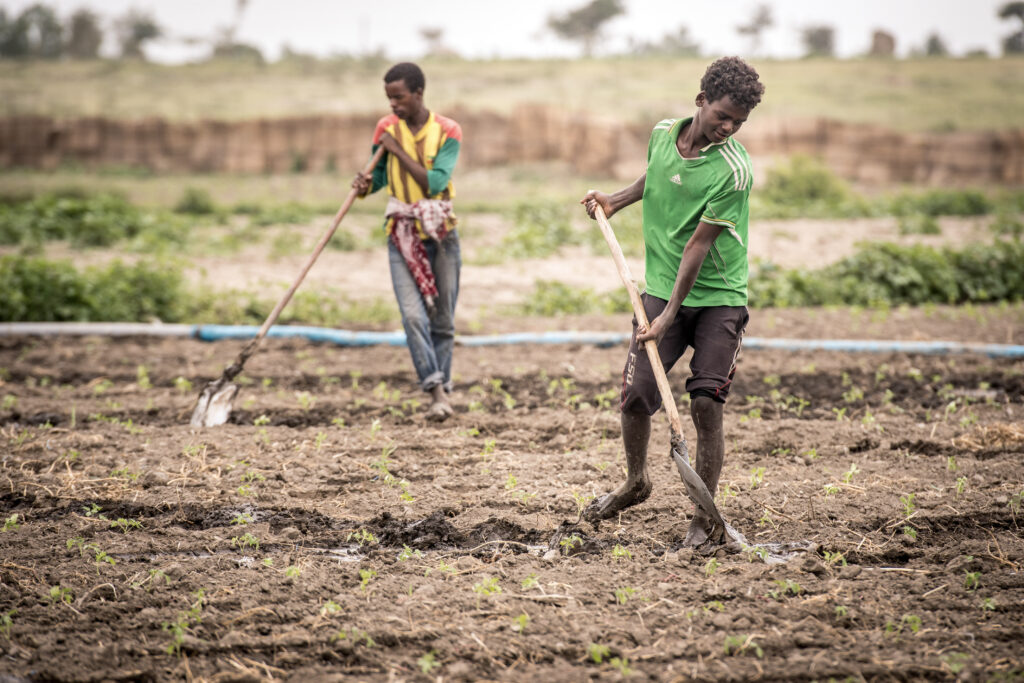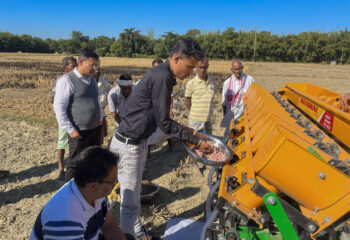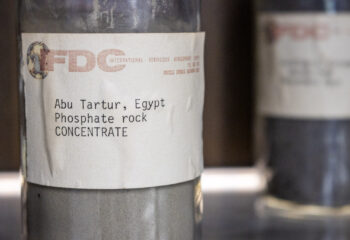
This blog is adapted from the IFDC paper “Fertilizer and Soil Health in Africa: The Role of Fertilizer in Building Soil Health to Sustain Farming and Address Climate Change.”
According to the United Nations, the world population is set to reach 9.8 billion by 2050. Sub-Saharan Africa is projected to have the fastest population growth rate globally, with the region’s number of inhabitants doubling by 2050 to reach 2.4 billion. Such rapid population growth strains land resources and contributes to food insecurity, malnutrition, and poverty – with negative environmental consequences. Addressing the demands of population growth will require increased agricultural productivity; however, food can only be as healthy as the farmlands that produce it. As such, we must recognize soil’s role in sustainably improving agricultural productivity and responsibly feeding an unprecedented number of people in 2050.

Healthy soils provide a nourishing foundation for feeding the growing population. They provide the nutrients that crops need to become nutritious food, store and supply water to plants, reduce the risk of drought and water stress, and decrease the need for mineral fertilizers and other inputs. Healthy soils also minimize crop failure and income loss due to climate change and other shocks. By improving soil health, we can sustainably increase agricultural productivity, ensure food security, and build resilient farming systems that address the challenges of population growth and climate change. Improving soil health requires investments in research and development, infrastructure, and business and policies that support sustainable and productive farming systems.
Background
During the Green Revolution in the 1960s, little attention was given to maintaining soil health. For example, Sanchez (1976, p. 180), in his seminal text on tropical soils, wrote: “When mechanization is feasible, and fertilizers are available at a reasonable cost, there is no reason to consider the maintenance of organic matter as a major management goal.” Since soil organic matter is a primary indicator of soil health, one can infer that soil health investments were not a significant priority and were not given much attention at the time. However, during the 1980s and 1990s, the focus on small-scale farms intensified, and the critical role of soil fertility was highlighted through the release of nutrient-depletion maps generated by IFDC.
The 2006 Abuja Declaration on Fertilizer for the African Green Revolution fostered an agreement among African Union member states to increase the availability and use of mineral fertilizer in sub-Saharan Africa, setting a target of 50 kilograms per hectare of nutrients. Moreover, it put forward the idea that reversing soil health degradation requires an Integrated Soil Fertility Management (ISFM) approach, which includes fertilizer and other locally available organic amendments, such as crop residues, composts, and green manures.

Prioritizing Soil Health
In sub-Saharan Africa, traditional or indigenous farming practices are still being applied; however, these practices have not been able to sustain or intensify crop production, especially with increasing population densities and a reduction in or lack of fallow land. Future soil policies should focus on making information and data accessible to stakeholders, including information that promotes the understanding that soil health serves as the basis for long-term productivity and the economic and social benefits that follow. Actors must be aware of the state of their soil health and the effectiveness of various management techniques, such as slash-and-burn field preparation.
Smallholder farmer productivity is constrained by labor, cash, and organic resources. Farmers are more likely to invest in soil and land management practices when land tenure is secured, markets work, appropriate credit is accessible, and agricultural extension services provide appropriate advice. The main deterrent to soil health investments lies in the mismatch between actors’ preferences and priorities and the time it takes to reap the benefits of healthy, well-managed soils. The long period between the initial investment in good soil health practices and realizing the benefits of improved soil health is a disincentive for actors, especially smallholders on leased or other non-owned land. Therefore, further responsibility for and investments in soil health must be shared by many value chain actors, including farmers, private sector actors, governments, and policymakers, to improve soil health and fertility.
In the case of smallholder farmers, the inability to prioritize soil health results in the inefficient use of scarce resources (land, labor, and capital), guarantees the yield gap persists or worsens and, in extreme cases, relegates farm households to a degraded-soil poverty trap.
Land clearing, climate change, and improper soil management also cause soil health and fertility to decline. The impact of this deterioration becomes evident only in the long term, when soil restoration comes at a much higher cost. Policymakers, private sector actors, and other stakeholders must be responsible for creating viable conditions for sustainable soil management and developing mechanisms that result in the appropriate soil valuation.

Improving Soil Health
With soil degradation affecting many parts of the world, the paradigm must shift from sole crop yield increase to include soil health improvement to enhance the resilience of the agricultural systems to a changing climate. In addition to enhancing the efficient use of fertilizers, a supportive, engaging policy and business environment will be necessary to improve soil health globally and support the 9.8 billion individuals expected to live on the planet in 2050. Interventions by policymakers and the private sector must support the delivery of targeted, digitally enabled fertilizer management recommendations and create favorable social and economic conditions that allow smallholder farmers to implement these recommendations at scale. Policies to enhance extension services and agricultural advisories that include good soil health management practices, as well as good agronomic practices, water management, weather-crop insurance, and market information, are critical. Access to data and analytics to monitor the status of, and changes in, soil health should be facilitated, and medium- to long-term data on the impact of farmers’ practices on soil health properties should be collected and analyzed. Policymakers also need reliable estimates of soil health’s benefits to environmental outcomes and ecosystem services, including the land spared from agriculture through sustainable intensification. In this transition, the private sector has a responsibility for and must play an important role in creating economically viable opportunities for farmers to adopt soil health improvement practices.
Improving fertilizer use efficiency is also crucial for supporting a growing population because it can help increase crop yields, maximizing farmers’ return on investment and lessening the environmental impact, while improving soil health and food security. At current application rates in sub-Saharan Africa, soil nutrient mining continues to contribute to substantial soil degradation. If left unaddressed, the soil upon which farmers depend will become entirely depleted and nonresponsive. Sufficient nutrient and carbon recycling for food security can only be achieved in healthy, fertile, and productive soils. Therefore, agricultural intensification in sub-Saharan Africa should be supported by science-based agronomic approaches to:
- Enhance the affordability and availability of fertilizers.
- Spatially target fertilizer recommendations.
- Co-design with farmers integrated soil, water, and crop management practices.
- Develop incentives for farmers to allow long-term investments in their soils.
With healthy soils, food production can match or exceed food demand, even in the face of rapid population growth, by increasing crop yields and improving food security. Mineral fertilizers are essential for higher crop yields and most effective when combined with other soil and crop management practices. Healthy and productive soils can halt farmland expansion, deforestation, and biodiversity loss. Policies designed to enhance fertilizer use must be linked to policies that support market development, such as infrastructure, post-harvest, commodity prices, import, and export, to ensure that increased crop yields translate into higher incomes for farmers. Measures should be in place that link farmers to profitable markets and to other incentives that add value to soils to encourage farmers to reinvest in fertilizers and soil health practices. With judicious fertilizer use, viable business opportunities, and supporting policies, healthy soils can sustainably improve agricultural productivity, responsibly enabling the planet to feed 9.8 billion people by 2050.




